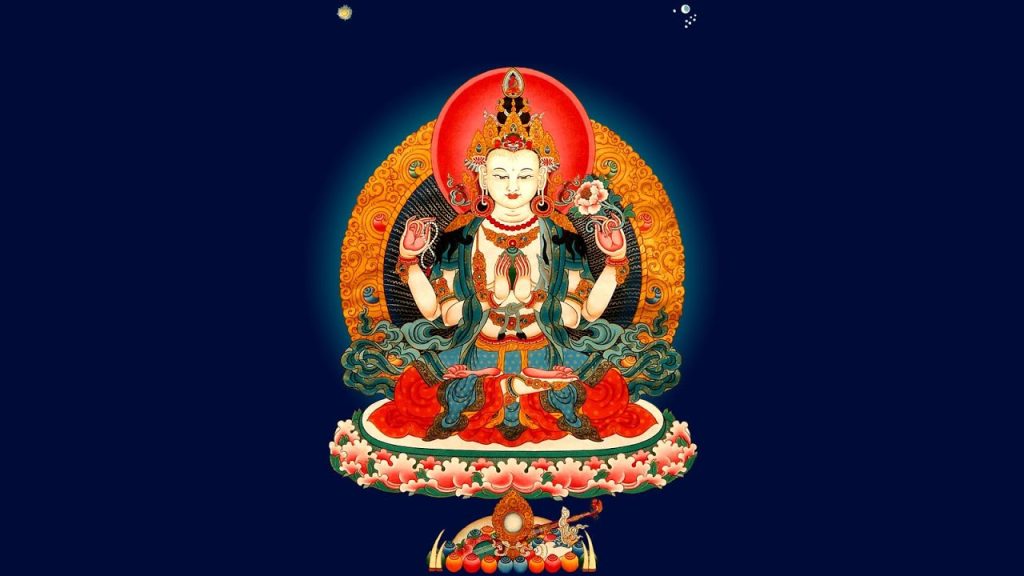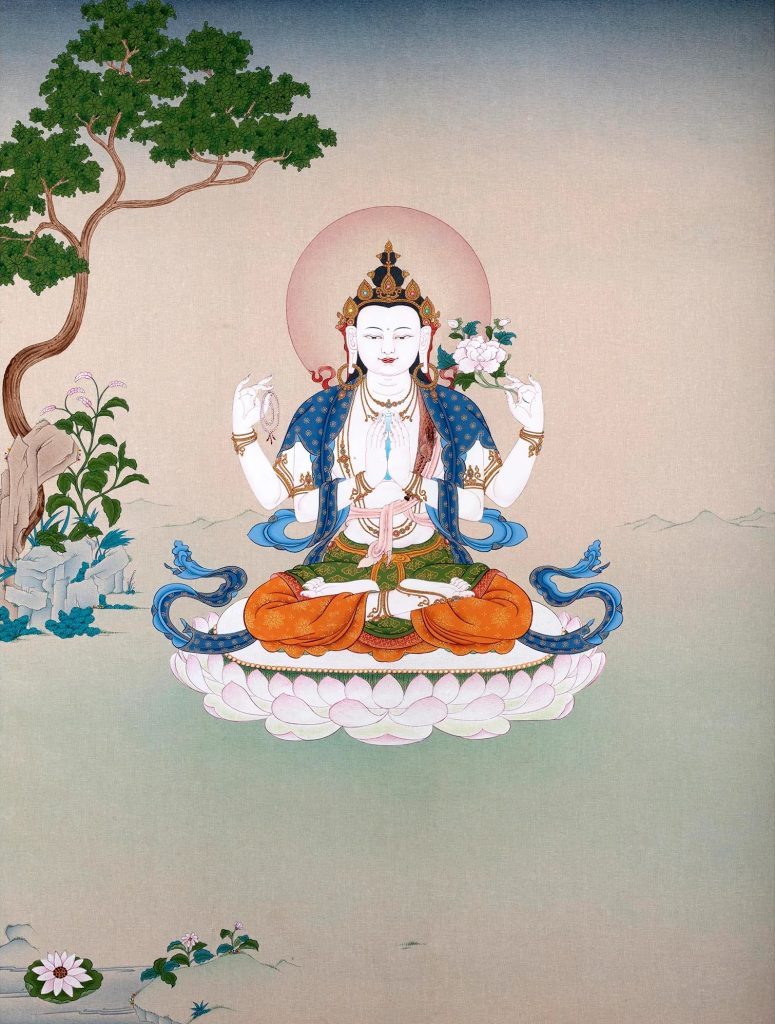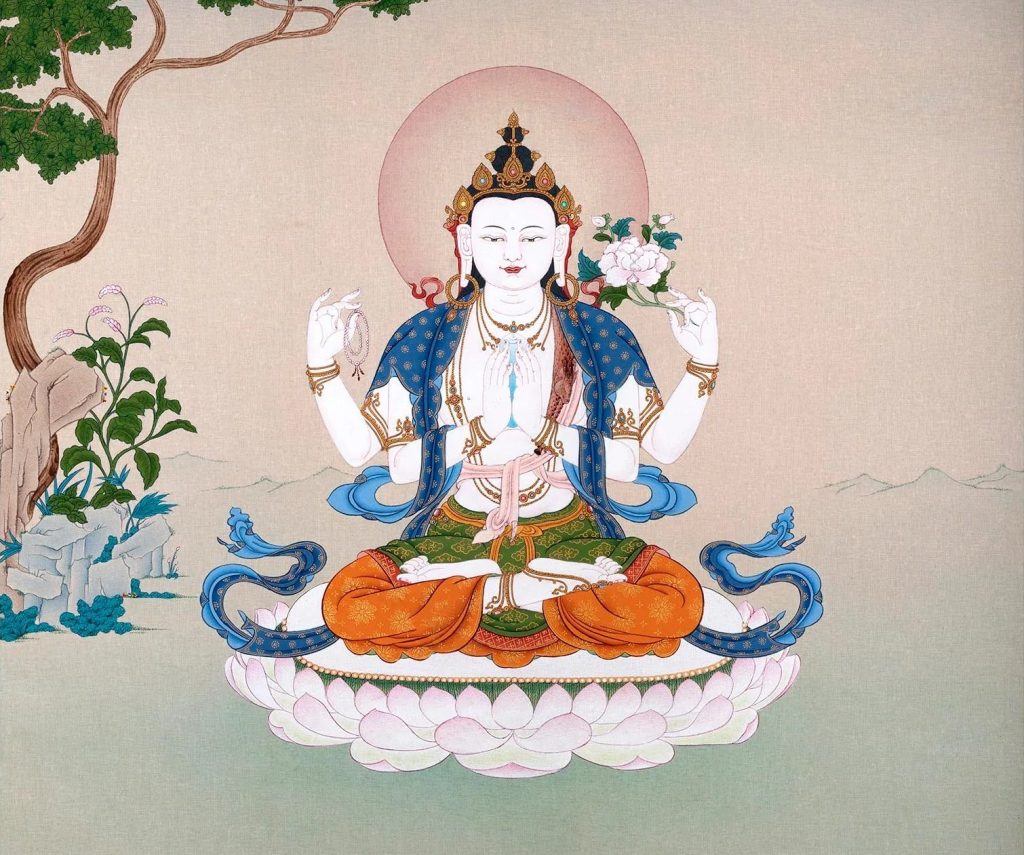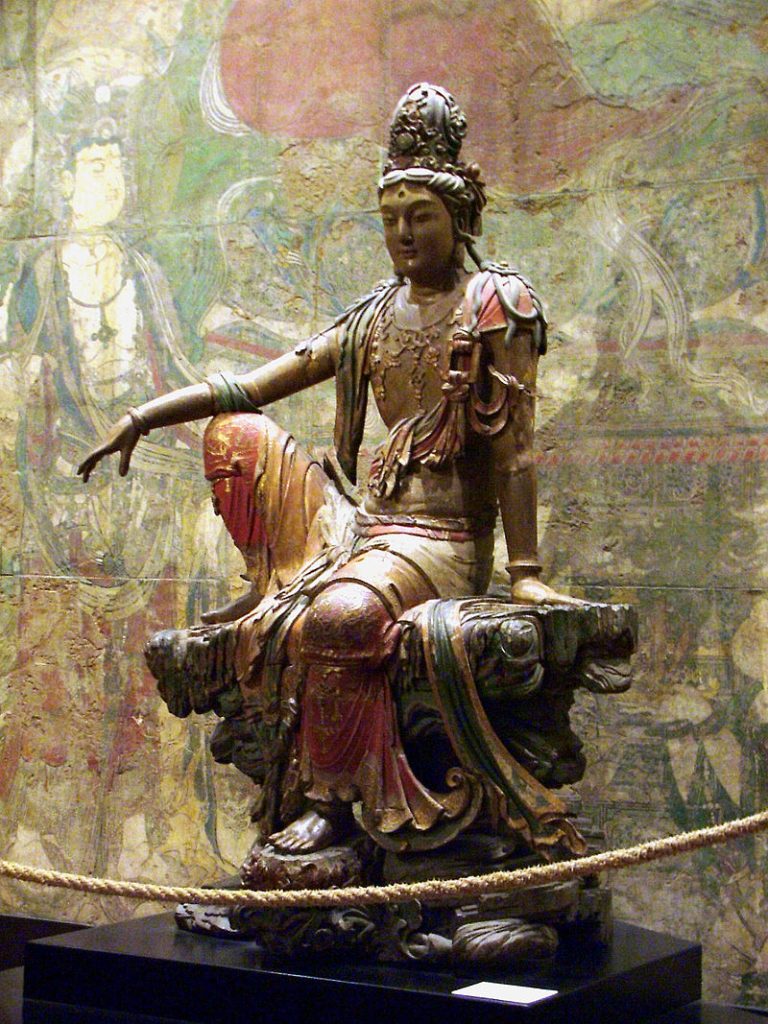Tuesday
Meeting Chenrezig in Sound: Understanding Chenrezig’s Name and the Meaning of the Chenrezig Mantra
by Frederick Meyer
An excerpt from the Shambhala Online Blog posted April 12, 2024
In recent years, Chenrezig—the Tibetan name for the Buddhist deity Avalokiteshvara, the Bodhisattva of compassion—has become an important part of my spiritual practice. I have a strong affinity for sound, and much of my learning about Chenrezig has been in the form of sound and meaning: what “Chenrezig” itself means and how it relates to Avalokiteshvara’s other names, what the Sanskrit and Tibetan versions of the word compassion actually mean, and the meaning of the famous Chenrezig mantra OM MANI PADME HUM.
In this article, I want to share both what I’ve learned about Chenrezig himself, as well as my own process of exploration. I feel the process I’ve followed shows how association and meaning can unfold along the Buddhist path, especially the parts of the path that are rich in energy and iconography.
Throughout this article, I’ll be describing what I learned about Chenrezig in my explorations , as well as weaving in Chögyam Trungpa Rinpoche’s teachings on the same topic. I only discovered Trungpa Rinpoche’s teachings on Chenrezig within the past month, so it’s been very interesting to compare my own independent learning with his teaching, and I hope to illustrate that dynamic as well.
Chenrezig: First Connections
I had heard of Chenrezig growing up, but I didn’t connect strongly to Chenrezig until around three years ago, when my father, a longtime Buddhist practitioner, began practicing Four-Armed Chenrezig sadhana practice with a Tibetan Lama living in Hawaii. At his suggestion, I began joining for the weekly sadhana practice.
The lama often played a YouTube video (with the sound off) during the visualization part of the sadhana. The video includes a thangka of Chenrezig that I really like—something about the eyes and facial expression, and the vibrant colors. I found that looking at it gave me a certain feeling, and I began to carry that with me.

Because of his enthusiasm for the practice, I gifted my father a Chenrezig thangka for one of his birthdays, and then later bought one for myself. When my thangka arrived (about a year and a half ago now), I found that the energy of my own interest in and connection with Chenrezig heightened significantly.

From there, I began exploring Chenrezig in earnest, and that’s where I began to learn in depth about Chenrezig’s name, the meaning of compassion, and the meaning of the Chenrezig mantra.
Chenrezig: What the Name Means
The Tibetan name Chenrezig means “continuously looking,” and has been translated as:
- “One who looks with unwavering eye”
- “Unblinking Eyes”
- “One who always looks upon all beings (with the eye of compassion)”
Trungpa Rinpoche translates Chenrezig as: “He Who Sees All Sentient Beings.”
Chenrezig is the Tibetan version of the Sanskrit name Avalokiteshvara, which means “lord who gazes upon the world.” The idea of this name (in both Sanskrit and Tibetan) is that the loving gaze of compassion—the gaze of Chenrezig, compassion itself—forever holds all beings.
Avalokitasvara: The Female Compassion Deity
What I find most interesting about Chenrezig’s name is that there is another form of the Sanskrit name Avalokiteshvara. Wikipedia does a wonderful job summarizing the history, and it felt like a major revelation to me when I read it. The other name is Avalokitasvara: “Who hears the cries of the world.”
Western scholars originally thought this name had been made up, in error, by Chinese translators from Sanskrit, who named the deity Guanshiyin, “[The One Who] Perceives the Sounds of the World,” or “who perceives the world’s lamentations.” Shortened to Guanyin (and later rendered in Japan as Konan), this is the contemporary Chinese name for Avalokiteshvara, who is represented as a female compassion deity.
Scholars later realized that Avalokitasvara is actually a correct—and older—name of the deity, which was later developed into Avalokiteshvara (adding the sense of “lord” and changing “hear” to “see”). Guanshiyin, “Who Hears the Cries of the World,” wasn’t a mistranslation at all.
As I mentioned, I have a strong affinity for sound, and learning this alternate name of Chenrezig had a profound effect on me. One who gazes (lovingly) upon the world sounds, to me, nice but a little distant—but “hearing the world’s cries” carries a strong feeling I can immediately connect with.
In fact, many of my most immediate and piercing experiences of compassion have been sound-based. As an example, I have a small dog, and this morning when I picked her up, she yelped loudly (I don’t know why, and she wasn’t hurt). I was immediately pierced by a feeling that was so immediate I didn’t have a name for it. I feel it was a strong hit of compassion—the powerful, immediate, primordial feeling that is true compassion, not the refined notion of charity and concern for others that we might often think of.
To continue reading Meeting Chenrezig in Sound: Understanding Chenrezig’s Name and the Meaning of the Chenrezig Mantra by Frederick Meyer please visit the Shambhala Online Blog webpage here.
Entries filed under Community Articles
The Practice of Losing My Job – HIGHLIGHT
In November, I survived the first round of layoffs. To celebrate, I joined my coworkers at a Mexican restaurant for lunch. We filled a big table and most of us are under thirty, so the waiter served us free Tequila shots. I remember the way we ... continuePosted April 10, 2009 by Jennifer Holder
On the Razor’s Edge: First Time at MPE – HIGHLIGHT
Last summer, I went to Magyal Pomra Encampment (MPE). If there were any program where the Buddha’s teaching that the dharma is based upon experience rings true, this is one of those. Self-secret. Yet somehow, I feel compelled to share some of my experience. I was scared ... continuePosted April 8, 2009 by
Habitual Patterns by Chögyam Trungpa Rinpoche
Dear Sangha, In celebration of the Parinirvana of the Vidyadhara Chogyam Trungpa Rinpoche, and in honor of his extraordinary, blazing and luminous mind, I’d like to make my yearly offering of a musical piece I wrote and recorded using his words from a 1979 Kalapa ... continuePosted April 4, 2009 by alan_anderson
Confidence by Steve Clorfeine
I still reflect on some of the things the Vidyadhara said 30 years ago, about: the uplifting of education, the development of self-confidence and most of all the confidence he placed in us particularly the artists (who were always questioning themselves). It was in the years of the ... continuePosted April 3, 2009 by
“How do you put the soap back in the dish?” and other short stories by Herb Elsky
At a Los Angeles Dharma Art seminar 1980 Trungpa Rinpoche presented teachings about the connection between art and meditation practice. After the talk there was the question and answer period. One woman raised her hand and said that she was a computer programmer but that what ... continuePosted April 3, 2009 by
Meeting the Guru I Never Knew – HIGHLIGHT
The Vidyadhara’s presence is so profoundly with us, as the Sakyong says in THE DIRECT ANTIDOTE: “He is, in fact, here in the present, now more than ever. Even though many people… have never met him, he somehow has seeped into their inspiration.” How did you ... continuePosted April 3, 2009 by
Shambhala Time Out
New Inter-species Study Group a Great Success Patience seems to be the key word during walking meditation with snails. Weekend morning drill practice with howler monkeys upsets neighbors. Resident Elephant Director gives astonishing Friday night public talk… Click here for details continuePosted April 1, 2009 by
Awakened Early, and Often: Family Camp at Dorje Denma Ling – HIGHLIGHT
#gallery-1 { margin: auto; } #gallery-1 .gallery-item { float: left; margin-top: 10px; text-align: center; width: 33%; } #gallery-1 img { border: 2px solid #cfcfcf; } #gallery-1 .gallery-caption { margin-left: 0; } /* see gallery_shortcode() in wp-includes/media.php */ Family Camp 2008 at Dorje Denma Ling was wonderfully successful with over 40 parents and children coming together for a week of practice, lawn games, ... continuePosted March 23, 2009 by
Mindful Parenting
As anyone who has practiced meditation is likely to know, being able to remain seated and watch the mind without judgment is much harder than it sounds. However, that pales in comparison to the challenges I’ve faced as a parent, as anyone who has helped raise ... continuePosted March 20, 2009 by
Bringing Peace Into Your Home With Family Meditation – HIGHLIGHT
Happiness comes from slowing down and cultivating a peaceful place inside together as a family. A daily dose of meditation helps family members – Self-soothe and settle energy … and relieve anxiety Develop clarity … and prevent anger and resentment Increase empathy … and decrease “Me first” and “I want” Strengthen ... continuePosted March 20, 2009 by Kerry Lee MacLean
Elternsein als Pfad: Wie wir Zuversicht in unseren Kindern nähren
Achtsamkeit im Leben mit den Kindern üben Was Kinder sehr von Eltern brauchen ist Achtsamkeit: ganz und gar da sein. Kinder leben in der Gegenwart im Hier und Jetzt, nicht in der Zukunft und nicht in der Vergangenheit. Wenn wir jedoch stets beschäftigt sind und uns von unseren ... continuePosted March 20, 2009 by
Shambhala Rainbows: Gay in Shambhala
In 1995 I was a 24-year old club kid working for a vintage clothing store called “Flashy Trash” in Boystown, Chicago. When, in the midst of some temper tantrum, the woman I worked with joked that I should learn how to meditate, that moment, triggered something ... continuePosted March 18, 2009 by Zane Edwards
Reflections on Shambhala Day
It certainly didn’t feel like an auspicious day when I woke up that morning. The last part of the don season stuck me with a nasty cold and as I poured myself into my suit I couldn’t help but gain confidence that the year of the ... continuePosted March 16, 2009 by
My Turn in the Barrel: the Weekthun Experience near Houston, Texas – HIGHLIGHT
#gallery-2 { margin: auto; } #gallery-2 .gallery-item { float: left; margin-top: 10px; text-align: center; width: 33%; } #gallery-2 img { border: 2px solid #cfcfcf; } #gallery-2 .gallery-caption { margin-left: 0; } /* see gallery_shortcode() in wp-includes/media.php */ Written for the Dot by Bob Williams In Texas we say, “It’s your turn in the barrel!” when you’re center stage and under fire. Why? Because ... continuePosted March 16, 2009 by
Level One for People of Color – HIGHLIGHT
By Ivette Guillermo, Elaine Yuen and Steve McGahee In January 2009, the Philadelphia Shambhala Center conducted a Shambhala Training Level One for people of color. Some asked, Why do this? Why separate, why make note of difference? Isn’t Shambhala Training already unbiased and open to everyone? The reality ... continuePosted March 12, 2009 by
![]() RSS feed for the Community Articles category
RSS feed for the Community Articles category
View all posts from authors in Community Articles: Jillian_Johnson































